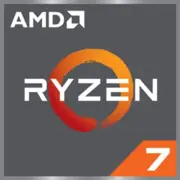AMD Ryzen 7 2700E

AMD Ryzen 7 2700E: An Energy-Efficient Workhorse for Specific Tasks
Overview of a processor that remains relevant in 2025 despite its age
Key Features: Zen Architecture and Balance Between Power and Efficiency
The AMD Ryzen 7 2700E, released in 2018, continues to be in demand in 2025 thanks to its unique combination of characteristics.
- Zen Architecture (1st Generation): Although Zen lags behind modern Zen 4 and Zen 5 in IPC (instructions per cycle), its 8 cores and 16 threads provide consistent multi-threaded performance.
- 12nm Process Node: By 2025 standards, this is considered outdated, but it still performs effectively for moderately demanding tasks.
- Performance: In Geekbench 6, the processor scores 1039 in single-thread and 4640 in multi-threaded tests. This is comparable to the Intel Core i5-12400 (approximately 1100/5500), but with a lower TDP.
- Key Features:
- Low power consumption (TDP 45W).
- Support for PCIe 3.0 (relevant for budget builds).
- Precision Boost and XFR technologies for automatic overclocking.
Practical Example: In 2025, the Ryzen 7 2700E is often chosen for building home servers or media centers, where silence and minimal heat output are important.
Compatible Motherboards: AM4 and Choosing Wisely
The processor uses the AM4 socket, making it compatible with a wide range of motherboards.
- Chipsets:
- B450/X470: Optimal choice. Boards like the MSI B450 Tomahawk Max (price: $80-100) support the processor after a BIOS update.
- B550/X570: Compatible but excessive due to the lack of PCIe 4.0 in the 2700E.
- Selection Tips:
- Check processor support on the manufacturer's website (not all boards have been updated for older chips).
- For stable operation of an 8-core CPU, choose boards with VRM modules of at least 4+2 phases (e.g., ASUS TUF B450-Plus Gaming).
Tip: If building a system from scratch, consider budget B450 boards, as they are 20-30% cheaper than B550 boards and will fully unleash the potential of the 2700E.
Supported Memory: DDR4 and Optimization
The Ryzen 7 2700E only works with DDR4.
- Officially Supported Frequencies: Up to 2933 MHz.
- Recommendations:
- Use dual-channel kits (2×8 GB or 2×16 GB).
- Optimal frequency is 3200 MHz (setup via XMP). For example, Kingston Fury DDR4-3200 (price: $50 for 16 GB).
- Avoid memory with high timings (CL18 and above) — Ryzen is sensitive to latencies.
Example: Users report that upgrading from 2400 MHz to 3200 MHz increases rendering performance by 7–10%.
Power Supply: Minimalism Without Compromise
With a TDP of 45W, the Ryzen 7 2700E is one of the most energy-efficient 8-core processors.
- Power Supply Recommendations:
- For systems without a discrete graphics card (office PCs, NAS), a 300W PSU is sufficient (e.g., be quiet! Pure Power 11 300W, $45).
- With a graphics card like the NVIDIA RTX 3060 (TDP 170W), choose a PSU rated at 500–600W (Corsair CX550M, $65).
- Energy Efficiency: Even under load, the processor rarely consumes more than 60W, reducing the strain on the cooling system.
Tip: Don’t skimp on the PSU — even for low-power systems, a quality unit can minimize the risk of voltage spikes.
Pros and Cons: Who Should Choose the 2700E?
Pros:
- Low power consumption and heat output.
- 8 cores/16 threads for $150–180 (new, 2025).
- Compatibility with inexpensive motherboards.
Cons:
- Outdated 12nm manufacturing process.
- No PCIe 4.0 or DDR5 support.
- Weak single-thread performance compared to modern CPUs.
Use Cases: Where is the 2700E Still Relevant?
1. Office and Multimedia PCs:
- 4K video streaming, document handling, web browsing.
2. Home Servers/NAS:
- Low TDP allows the system to run 24/7.
3. Budget Workstations:
- Rendering in Blender, video encoding (HandBrake).
4. Gaming (with caveats):
- Paired with a GPU like the RTX 3060, the CPU can handle gaming at medium settings (1080p).
Example: In 2025, the 2700E is popular among streamers using PCs for broadcasting and simultaneous video processing.
Comparison with Competitors: Who Does the 2700E Outperform?
- Intel Core i5-12400 (2022):
- Better in single-thread tasks (+15%), but more expensive ($180) with only 6 cores.
- AMD Ryzen 5 5600G (2021):
- Integrated graphics, but only 6 cores and a TDP of 65W. Price: $160.
- Intel Xeon E-2288G (2019):
- Server equivalent, but its price ($400) makes it a niche solution.
Conclusion: The Ryzen 7 2700E excels in the “many cores for minimal investment” segment.
Practical Assembly Tips
1. Motherboard: Choose a B450 with guaranteed Zen support (e.g., Gigabyte B450 Aorus Elite).
2. Cooling: The stock cooler is sufficient, but for quiet operation, consider the DeepCool GAMMAXX 400 ($25).
3. Storage: An NVMe SSD (e.g., Kingston NV2 1TB, $60) will speed up system boot times.
4. Case: Mini-ITX cases like the Cooler Master NR200 are suitable for compact builds.
Final Conclusion: Who Should Consider the Ryzen 7 2700E?
You should choose this processor if you:
- Are building a budget system focused on multi-threading.
- Need energy efficiency (home server, office).
- Are not willing to pay extra for the latest technologies (DDR5, PCIe 5.0).
As of 2025, the Ryzen 7 2700E presents a solid compromise between price, performance, and energy savings. It may not be for enthusiast gamers, but it suits practical users who appreciate balance.
Basic
CPU Specifications
Memory Specifications
GPU Specifications
Miscellaneous
Benchmarks
Compared to Other CPU
Share in social media
Or Link To Us
<a href="https://cputronic.com/index.php/cpu/amd-ryzen-7-2700e" target="_blank">AMD Ryzen 7 2700E</a>